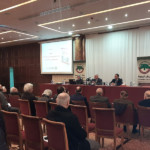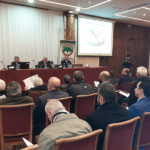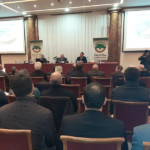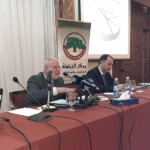In a press conference held, on 9/1/2020, al-Zayotuna Centre announced the major conclusions of the Palestine Strategic Report 2018-2019 (PSR 2018-2019) with projections to 2020-2021.
The report is scientifically documented and supported by dozens of tables, statistics, and charts. It was authored by a group of 14 specialists, including: Mr. Ashraf Bader, Mr. Basem al-Kassem, Mr. Hani al-Masri, Ms. Iqbal ‘Omeish, Dr. Johnny Mansour, Dr. Moein Muhammad ‘Atta Ragab, Mr. Rabi‘ al-Dannan, Dr. Sa‘id al-Haj, Mr. Sari Orabi, Prof. Dr. Talal ‘Atrissi, Mr. Wael Sa‘ad, Prof. Dr. Walid ‘Abd al-Hay, Mr. Wi’am Hammoudah and Mr. Ziad Bhies. It is reviewed by a specialized advisory body.
The Report’s editor and al-Zayotuna’s General-Manager Prof. Dr. Mohsen Mohammad Saleh announced these conclusions, by introducing the report as the eleventh volume of the PSR series, which started to be published in 2005.
First, Saleh presented the conclusions concerning the internal Palestinian situation, including the development of the Palestinian national project, the conditions of the PA and PLO and its institutions, Palestinian schism and its impact on the internal Palestinian scene, in addition to the Palestinian-Israeli security coordination. He explained the latest Palestinian demographic indicators, including the number of Palestinians in the world and the number of refugees. As for the Palestinian economic indicators, he stated the latest numbers concerning the Palestinian GDP, trade and other indicators.
Saleh focused on the latest conditions of the Palestinian land and holy sites, including the US recognition of Jerusalem as the capital of Israel, the movement of the US embassy to Jerusalem, Judaization activity, and settlement activity, etc.
Concerning the Palestinian resistance operations, Saleh discussed the latest developments of the Palestinian resistance action, the return marches, in addition to the suffering of the Palestinian prisoners in Israeli prisons and their latest numbers.
The report has a whole chapter on the Israeli scene and its demographic, economic and military indicators. It explains the domination of “nationalist” extremism, and the crisis of the structure of the political system. It brings to the reader the updated numbers of Jews, Israeli GDP, the economic, military and technological progress, while discussing the many crises and strategic threats Israel is currently facing.
The report discusses the status of the peace process, the latest development and details of what is known by the media as the “deal of the century.” It notes that the deal’s leaks abandon the previously approved references in the peace process, such as the international law and UN resolutions, and seek to establish a de facto reference.
Saleh then moved to the latest developments concerning the Palestine issue and the Arab World, which continues to suffer from weakness and division, and internal problems and conflicts. The report discusses the relation of a number of Arab countries with the Palestine issue, including Egypt and Qatar, in addition to discussing the manifestations of official normalization with Israel, especially by the Gulf countries.
The report has a whole chapter that explains the latest relations of the Muslim world with the Palestinian issue, including those of the Organization of Islamic Cooperation (OIC), Turkey, Iran and other Muslim countries, especially Malaysia, Indonesia, Pakistan and Nigeria…
Saleh explained the current international situation and its impact on the Palestine issue, especially the developments of the relations of the UN, US, EU, China, Russia, India with the Palestine issue. In addition to discussing the latest decision of the Prosecutor of the International Criminal Court (ICC), Fatou Bensouda.
At the end, Saleh stated the most prominent pathways that the Palestine issue will pass through during2020-2021, including:
• The crisis of the Palestinian national project would continue, the PLO status and efficiency would deteriorate, and the Palestinian schism and the conflict between the resistance and peace tracks would continue, in light of the current Palestinian leadership insistence on dominating the decision-making.
• The PA erosion would continue, where the occupation would continue to empty it of any national content while amplifying its living and security role, under its hegemony.
• During 2020, it is unlikely that free and fair PLC elections would be held in WB and GS, where all Palestinian forces would participate.
• Security coordination between the PA in Ramallah and Israel would continue.
• As long as GS is ruled by resistance forces, the siege would continue, albeit to varying degrees.
• Israel would take advantage of the Arab and Islamic deterioration and the unprecedented US support, hence the risk of the Judaization of Jerusalem and al-Aqsa Mosque and the attacks against Islamic and Christian holy sites would increase.
• The likelihood of Israel formally annexing parts of WB—such as the Jordan Valley and beyond the Separation Wall—would increase.
• The Palestinian economy in PA territories would remain dependent on the Israeli occupation.
• The peace process path is blocked, and the two-state solution would fall apart.
• The US promotion of what is known as the “deal of the century” among Palestinians and Arabs would fail, while seeking to impose some of its aspects on the ground.
• The steadfastness of the people in historic Palestine would continue, while their numbers would increase and exceed the population numbers of Jews.
• The capabilities of the Palestinian resistance would improve, and its qualitative fighting capabilities would increase.
• The Israeli society would become dominated more by religious and “nationalist” extremism.
• The strategic risks that Israel may face would increase.
• The “counter-wave” of the Arab Spring would reach its limit, be drained, and more cracks would appear in its walls, since there are signs that the pro- resistance forces are gradually recovering their vitality.
• The countries that have rushed into normalization with Israel would face more confusion and make their recalculation.
• The positive Turkish role in the Palestine issue would continue.
• The Iranian pro-Palestinian resistance role that refuses to recognize Israel would continue, and the chances of direct and indirect friction between Iran and Israel would increase.
• Despite the US-Israeli harmony, the official international position towards the Palestine issue would continue.
• The sympathy of the international public opinion with the Palestine issue would slowly and gradually increase, the activities of the BDS movement would increase, as well as the incrimination of the Israeli occupation.
The Executive Summary of this report will be published soon, followed by the publication of the volume “The Palestine Strategic Report 2019-2020.”








Leave A Comment